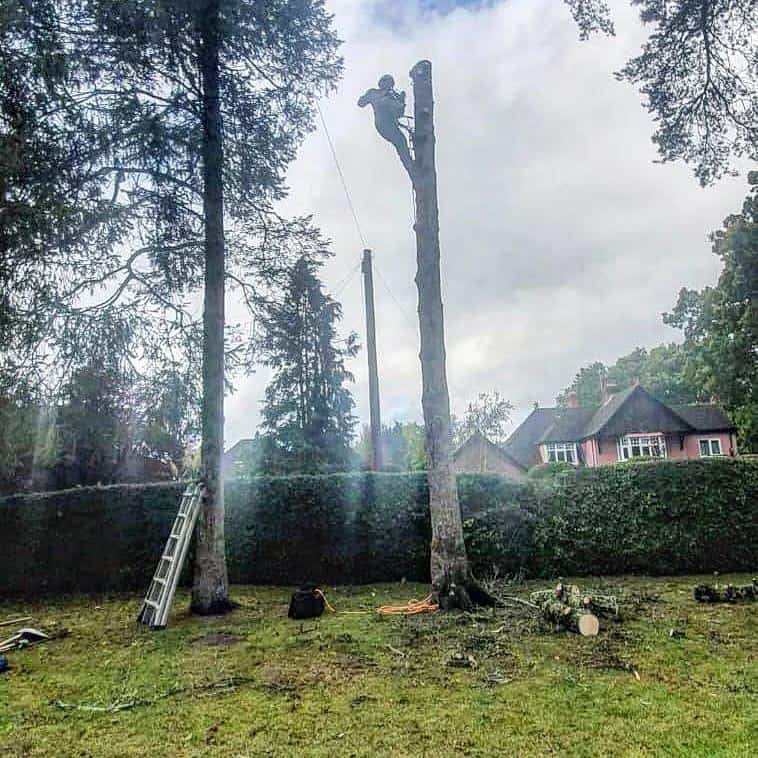Trees are a vital part of any landscape, offering shade, beauty, and environmental benefits. However, when branches become overgrown or unbalanced, they can pose risks to both the tree’s health and surrounding property. Targeted pruning — a precise and strategic approach to trimming — plays an essential role in maintaining tree structure, reducing excess branch weight, and preventing potential damage. At LM Tree Surgery Winchester, we specialise in professional pruning techniques that protect trees across Winchester and Hampshire, ensuring they remain safe, strong, and healthy for years to come.
Understanding Excess Branch Weight
As trees mature, their branches naturally grow thicker and longer. While this is a sign of healthy development, it can also create structural strain, particularly when branches extend too far from the trunk. The weight of heavy limbs increases the likelihood of:
- Splitting or cracking where the branch meets the trunk.
- Uneven weight distribution, leading to instability during storms.
- Fallen branches, especially during high winds or heavy rain.
- Internal stress, weakening the tree’s overall structure.
Excess branch weight doesn’t just threaten safety — it also limits airflow and light penetration within the canopy, affecting the tree’s vitality. Targeted pruning addresses these issues while promoting balanced, sustainable growth.
What Is Targeted Pruning?
Targeted pruning is a controlled process that removes specific branches to enhance a tree’s structure and reduce mechanical stress. Rather than cutting indiscriminately, each cut is made with purpose — focusing on branches that compromise the tree’s balance, health, or safety.
At LM Tree Surgery Winchester, our approach to targeted pruning includes:
- Assessing branch structure and load to determine which limbs are at risk.
- Removing weak or overextended branches to reduce leverage and strain.
- Maintaining a natural canopy shape while improving stability and airflow.
- Preserving healthy growth points to encourage proper regeneration.
This careful method ensures that the tree remains strong and visually appealing without unnecessary removal of foliage.
The Benefits of Reducing Branch Weight
1. Improved Structural Integrity
By lessening the strain on joints and trunk connections, pruning prevents fractures and failures. A well-balanced canopy distributes weight evenly, allowing the tree to withstand harsh weather conditions with less risk of breakage.
2. Enhanced Airflow and Light Penetration
Dense, heavy canopies can trap moisture and block sunlight, creating conditions where mould and pests thrive. Removing selected branches improves air circulation and allows more light to reach inner leaves, supporting overall tree health.
3. Prevention of Storm Damage
Heavy limbs are more likely to snap during strong winds. Reducing their weight lessens wind resistance, helping the tree sway naturally without fracturing. This not only protects the tree but also reduces the chance of property damage.
4. Encouraged Healthy Regrowth
When performed correctly, pruning stimulates new, balanced growth. By cutting at the right points, the tree redirects its energy to stronger, more stable branches, leading to improved resilience and vitality.
5. Enhanced Safety and Aesthetic Appeal
Overextended branches can hang dangerously close to buildings, pathways, or vehicles. Targeted pruning removes these risks while shaping the canopy for a cleaner, more attractive appearance that complements the surrounding landscape.
Recognising When a Tree Needs Weight Reduction
Homeowners in Winchester often notice signs that indicate when targeted pruning is necessary. Common indicators include:
- Large branches leaning excessively or growing unevenly.
- Cracks forming at the base of major limbs.
- Branches extending over roofs, driveways, or public areas.
- Dense foliage blocking light or trapping moisture.
- Dead or decaying branches within the canopy.
If any of these signs appear, it’s best to seek professional assessment. The arborists at LM Tree Surgery Winchester can identify where weight reduction is needed and apply techniques that maintain the tree’s natural structure.
The Techniques Used in Targeted Pruning
Reducing branch weight requires more than just trimming at random — it involves understanding tree biology, growth patterns, and load distribution. Common professional techniques include:
Crown Thinning
This technique removes selected branches throughout the canopy to reduce overall weight while maintaining a natural shape. It improves airflow and light penetration without altering the tree’s height or outline.
Crown Reduction
Used when a tree has become too large or top-heavy, crown reduction carefully shortens branches to balance weight and shape. Unlike topping, this method preserves the tree’s health and growth direction.
Deadwood Removal
Dead or decaying branches add unnecessary weight and can become dangerous. Removing them not only reduces strain but also prevents disease spread within the tree.
Selective Limb Removal
For trees growing near structures or walkways, selective pruning removes branches that pose potential hazards while keeping the tree stable and healthy.
At LM Tree Surgery Winchester, our qualified team uses these techniques according to each tree’s species, size, and condition to achieve the best results.
Why Professional Pruning Matters
Improper pruning can cause more harm than good. Cutting too much foliage or making incorrect incisions can weaken the tree, expose it to infection, or cause unbalanced regrowth. Professional tree surgeons understand the correct pruning angles, timing, and depth required to ensure each cut supports long-term health.
By choosing LM Tree Surgery Winchester, homeowners benefit from:
- Expert assessment of tree structure and stress points.
- Precision cuts that promote stability and natural growth.
- Equipment and safety measures suited for trees of all sizes.
- Environmentally responsible disposal of removed branches.
Maintaining Tree Health After Pruning
Once a tree has undergone targeted pruning, ongoing care helps sustain the results. Simple maintenance practices can make a big difference in keeping trees healthy and strong.
Recommended steps include:
- Regular inspections to monitor regrowth and structural changes.
- Mulching around the base to retain soil moisture.
- Avoiding soil compaction from vehicles or foot traffic near roots.
- Scheduling periodic pruning every few years to maintain balance.
These actions ensure that your tree continues to grow evenly without regaining excessive weight in the canopy.
Conclusion
Targeted pruning is one of the most effective ways to reduce excess branch weight and maintain tree safety. By removing only the necessary limbs, this approach prevents structural stress, encourages healthy regrowth, and preserves the tree’s natural beauty.
For homeowners in Winchester and throughout Hampshire, LM Tree Surgery Winchester provides expert pruning and tree maintenance services designed to keep your trees safe, balanced, and thriving. Through professional care and precise methods, we help you protect both your trees and your property for the long term.
Call us on: 01962 571 792
Click here to find out more about LM Tree Surgery Winchester
Click here to complete our contact form and see how we can help with your tree needs.

